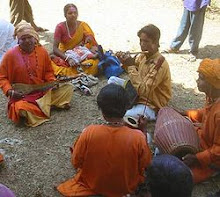
History of classical music traditions
Music is found in every known culture, past and present, varying wildly between times and places. Around 50,000 years ago, early modern humans began to disperse from Africa, reaching all the habitable continents. Since all people of the world, including the most isolated tribal groups, have a form of music, scientists conclude that music is likely to have been present in the ancestral population prior to the dispersal of humans around the world.[citation needed] Consequently music may have been in existence for at least 50,000 years and the first music may have been invented in Africa and then evolved to become a fundamental constituent of human life.[1]
A culture's music is influenced by all other aspects of that culture, including social and economic organization and experience, climate, and access to technology. The emotions and ideas that music expresses, the situations in which music is played and listened to, and the attitudes toward music players and composers all vary between regions and periods. "Music history" is the distinct subfield of musicology and history which studies music (particularly Western art music) from a chronological perspectivePrehistoric music
Prehistoric music, once more commonly called primitive music, is the name given to all music produced in preliterate cultures (prehistory), beginning somewhere in very late geological history. Traditional Native American and Australian Aboriginal music could be called prehistoric, but the term is commonly used to refer to the music in Europe before the development of writing there. It is more common to call the "prehistoric" music of non-European continents – especially that which still survives – folk, indigenous, or traditional music. Prehistoric music (previously called primitive music) is a term in the history of music for all music produced in preliterate cultures (prehistory), beginning somewhere in very late geological history. Prehistoric music is followed by ancient music in most of Europe (1500 BCE) and later musics in subsequent European-influenced areas, but still exists in isolated areas.
Prehistoric music thus technically includes all of the world's music that has existed before the advent of any currently-extant historical sources concerning that music, for example, traditional Native American music of preliterate tribes and Australian Aboriginal music. However, it is more common to refer to the "prehistoric" music of non-European continents – especially that which still survives – as folk, indigenous or traditional music. The origin of music is known as it occurred prior to the advent of recorded history. Some suggest that the origin of music likely stems from naturally occurring sounds and rhythms. Human music may echo these phenomena using patterns, repetition and tonality. Even today, some cultures have certain instances of their music intending to imitate natural sounds. In some instances, this feature is related to shamanistic beliefs or practice.[2][3] It may also serve entertainment (game)[4][5] or practical (luring animals in hunt)[4] functions.
It is possible that the first musical instrument was the human voice itself, which can make a vast array of sounds, from singing, humming and whistling through to clicking, coughing and yawning. In 2008 archaeologists discovered a bone flute in the Hohle Fels cave near Ulm, Germany.[6] [7] The five-holed flute has a V-shaped mouthpiece and is made from a vulture wing bone. The oldest known wooden pipes were discovered near Greystones, Ireland, in 2004. A wood-lined pit contained a group of six flutes made from yew wood, between 30 and 50cm long, tapered at one end, but without any finger holes. They may once have been strapped together.[8][dead link]
Biblical period
Main article: History of music in the biblical period

c. 960, Constantinople
According to Easton's Bible Dictionary, Jubal was the inventor of musical instruments (Gen. 4:21). The Hebrews were much given to the cultivation of music. Their whole history and literature afford abundant evidence of this. After the Deluge, the first mention of music is in the account of Laban's interview with Jacob (Gen. 31:27). After their triumphal passage of the Red Sea, Moses and the children of Israel sang their song of deliverance (Ex. 15). But the period of Samuel, David, and Solomon was the golden age of Hebrew music, as it was of Hebrew poetry. Music was now for the first time systematically cultivated. It was an essential part of training in the schools of the prophets (1 Sam. 10:5; 19:19-24; 2 Kings 3:15; 1 Chr. 25:6). There now arose also a class of professional singers (2 Sam. 19:35; Eccl. 2:8). Solomon's Temple, however, was the great school of music. In the conducting of its services large bands of trained singers and players on instruments were constantly employed (2 Sam. 6:5; 1 Chr. 15; 16; 23;5; 25:1-6). In private life also music seems to have held an important place among the Hebrews
Music and theatre scholars studying the history and anthropology of Semitic and early Judeo-Christian culture, have also discovered common links between theatrical and musical activity in the classical cultures of the Hebrews with those of the later cultures of the Greeks and Romans. The common area of performance is found in a "social phenomenon called litany," a form of prayer consisting of a series of invocations or supplications. The Journal of Religion and Theatre notes that among the earliest forms of litany, "Hebrew litany was accompanied by a rich musical tradition:"[10]
- "While Genesis 4.21 identifies Jubal as the “father of all such as handle the harp and pipe,” the Pentateuch is nearly silent about the practice and instruction of music in the early life of Israel. Then, in I Samuel 10 and the texts which follow, a curious thing happens. “One finds in the biblical text,” writes Alfred Sendrey, “a sudden and unexplained upsurge of large choirs and orchestras, consisting of thoroughly organized and trained musical groups, which would be virtually inconceivable without lengthy, methodical preparation.” This has led some scholars to believe that the prophet Samuel was the patriarch of a school which taught not only prophets and holy men, but also sacred-rite musicians. This public music school, perhaps the earliest in recorded history, was not restricted to a priestly class--which is how the shepherd boy David appears on the scene as a minstrel to King Saul."[10]
Ancient music
The prehistoric era is considered to have ended with the development of writing, and with it, by definition, prehistoric music. "Ancient music" is the name given to the music that followed. The "oldest known song" was written in cuneiform, dating to 4,000 years ago from Ur. It was deciphered by Prof. Anne Draffkorn Kilmer (University of Calif. at Berkeley), and was demonstrated to be composed in harmonies of thirds, like ancient gymel,[11] and also was written using a Pythagorean tuning of the diatonic scale.
Double pipes, such as those used by the ancient Greeks, and ancient bagpipes, as well as a review of ancient drawings on vases and walls, etc., and ancient writings (such as in Aristotle, Problems, Book XIX.12) which described musical techniques of the time, indicate polyphony. One pipe in the aulos pairs (double flutes) likely served as a drone or "keynote," while the other played melodic passages. Instruments, such as the seven holed flute and various types of stringed instruments have been recovered from the Indus valley civilization archaeological sites.[12]
Indian classical music (marga) can be found from the scriptures of the Hindu tradition, the Vedas. Samaveda, one of the four vedas, describes music at length. The history of musical development in Iran (Persian music) dates back to the prehistoric era. The great legendary king, Jamshid, is credited with the invention of music. Music in Iran can be traced back to the days of the Elamite Empire (2,500-644 B.C). Fragmentary documents from various periods of the country's history establish that the ancient Persians possessed an elaborate musical culture. The Sassanid period (A.D. 226-651), in particular, has left us ample evidence pointing to the existence of a lively musical life in Persia. The names of some important musicians such as Barbod, Nakissa and Ramtin, and titles of some of their works have survived.
The term Early music era may also refer to contemporary but traditional or folk music, including Asian music, Persian music, music of India, Jewish music, Greek music, Roman music, the music of Mesopotamia, the music of Egypt, and Muslim music.
Early music
Early music is a general term used to describe music in the European classical tradition from after the fall of the Roman Empire, in 476 CE, until the end of the Baroque era in the middle of the 18th century. Music within this enormous span of time was extremely diverse, encompassing multiple cultural traditions within a wide geographic area; many of the cultural groups out of which medieval Europe developed already had musical traditions, about which little is known. What unified these cultures in the Middle Ages was the Roman Catholic Church, and its music served as the focal point for musical development for the first thousand years of this period. Very little non-Christian music from this period survived, due to its suppression by the Church and the absence of music notation; however, folk music of modern Europe probably has roots at least as far back as the Middle Ages

No comments:
Post a Comment